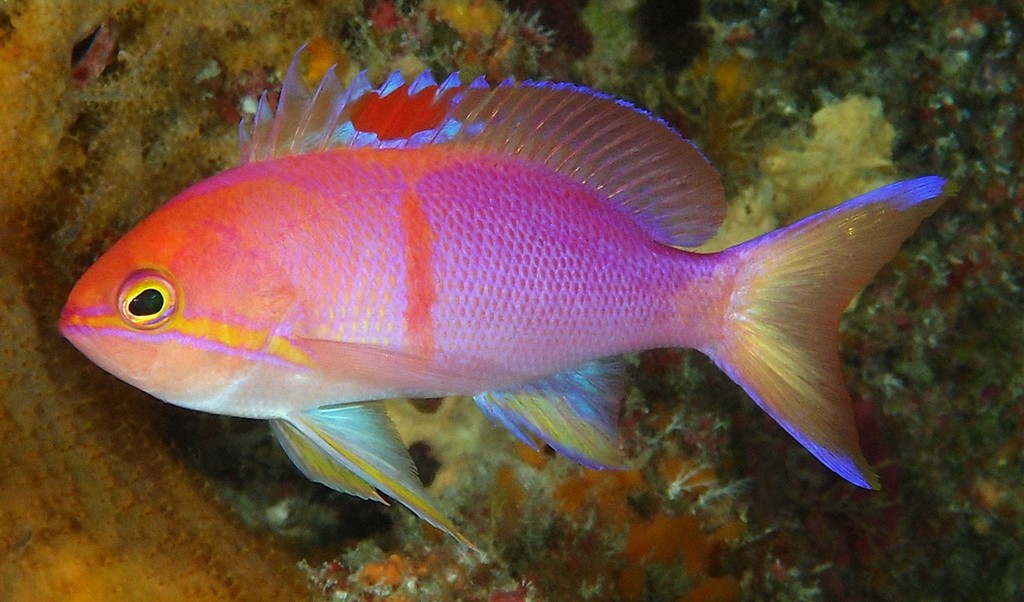PSEUDANTHIAS ENGELHARDI - (ALLEN & STARCK, 1982)
Actinopterygii (Gigaclass) > Actinopteri (Class) > Teleostei (Subclass) > Perciformes (Order) > Percoidei (Suborder) > Anthiadidae (Family) > Pseudanthias (Genus)
Anthias du récif barrière, Barrier reef anthias, Barrier reef basslet, Orangebar anthias, 恩氏拟花鮨,
Synonymes
Anthias engelhardi (Allen & Starck, 1982)
Pseudanthias carlsoni (Randall & Pyle, 2001)
Pseudanthias engelhardorum (Allen & Starck, 1982)
Anthias du récif barrière, Barrier reef anthias, Barrier reef basslet, Orangebar anthias, 恩氏拟花鮨,
Synonymes
Anthias engelhardi (Allen & Starck, 1982)
Pseudanthias carlsoni (Randall & Pyle, 2001)
Pseudanthias engelhardorum (Allen & Starck, 1982)
--------------------------
Description
Dorsal spines (total): 10; Dorsal soft rays (total): 16; Anal spines: 3; Anal soft rays: 7; Pectoral fin rays: 17; Gill rakers: 10-11 + 24-25; Lateral line scales: 42-45; Body depth: 2.55-2.6 in Standard Length. Margin of subopercle and interopercle serrate; Third dorsal spine longest, moderately prolonged in males; Caudal fin deeply emarginate; Pelvic fins reaching anal fin spines in females, anterior soft rays in males. Max. length: 10.0 cm TL. Depth range: 37 - 70 m.
Color
Light yellowish pink dorsally, the scales edged in orange, shading to pinkish white ventrally; Snout and head above and behind eye orange-yellow; Males with an orangish bar on side of body above outer part of pectoral fin.
Etymology
Pseudanthias: from Greek, pseudes = false + from Greek, anthias = a name of an unknow fish given by Aristotle in "History of Animals". This book, written in the fourth century BC, is one of the major texts on biology by the ancient Greek philosopher Aristotle (384-322 BC), who had studied at Plato's Academy in Athens.
engelhardori: in honor of the late Charles W. Englehard, Jr. (1917-1971), American businessman in mining, metals and horse racing, and his family, for their “numerous and generous philanthropic contributions” (the Charles Engelhard Foundation supported the junior author’s long-term ecological research on the northern Great Barrier Reef). Originally spelled engelhardi; Since name honors more than one person, spelling is emended to engelhardorum.
Original description: Anthias engelhardi Allen & Starck, 1982 - Type locality: Escape Reef, Great Barrier Reef, depth 58 meters, Australia.
Distribution
Southwestern Pacific: Great Barrier Reef (Queensland, Australia), Papua New Guinea, and Loyalty Islands (New Caledonia) to Fiji and Tonga.
Description
Dorsal spines (total): 10; Dorsal soft rays (total): 16; Anal spines: 3; Anal soft rays: 7; Pectoral fin rays: 17; Gill rakers: 10-11 + 24-25; Lateral line scales: 42-45; Body depth: 2.55-2.6 in Standard Length. Margin of subopercle and interopercle serrate; Third dorsal spine longest, moderately prolonged in males; Caudal fin deeply emarginate; Pelvic fins reaching anal fin spines in females, anterior soft rays in males. Max. length: 10.0 cm TL. Depth range: 37 - 70 m.
Color
Light yellowish pink dorsally, the scales edged in orange, shading to pinkish white ventrally; Snout and head above and behind eye orange-yellow; Males with an orangish bar on side of body above outer part of pectoral fin.
Etymology
Pseudanthias: from Greek, pseudes = false + from Greek, anthias = a name of an unknow fish given by Aristotle in "History of Animals". This book, written in the fourth century BC, is one of the major texts on biology by the ancient Greek philosopher Aristotle (384-322 BC), who had studied at Plato's Academy in Athens.
engelhardori: in honor of the late Charles W. Englehard, Jr. (1917-1971), American businessman in mining, metals and horse racing, and his family, for their “numerous and generous philanthropic contributions” (the Charles Engelhard Foundation supported the junior author’s long-term ecological research on the northern Great Barrier Reef). Originally spelled engelhardi; Since name honors more than one person, spelling is emended to engelhardorum.
Original description: Anthias engelhardi Allen & Starck, 1982 - Type locality: Escape Reef, Great Barrier Reef, depth 58 meters, Australia.
Distribution
Southwestern Pacific: Great Barrier Reef (Queensland, Australia), Papua New Guinea, and Loyalty Islands (New Caledonia) to Fiji and Tonga.
Biology
Occurs inshore, near small patch reefs at the bases of drop-offs. Forms aggregations.
Similar species
Pseudanthias charleneae (Allen & Erdmann, 2008) - Reported from Eastern Indian Ocean, western Pacific: Bali and West Papua (Indonesia).
Pseudanthias flavicauda (Randall & Pyle, 2001) - Reported from New Caledonia. Link to the species (here). Females are similar in color.
Pseudanthias tequila (Gill, Tea & Senou, 2017) - Reported from Western Pacific: Ogasawara Islands, Mariana Islands. Females are similar in color.
Occurs inshore, near small patch reefs at the bases of drop-offs. Forms aggregations.
Similar species
Pseudanthias charleneae (Allen & Erdmann, 2008) - Reported from Eastern Indian Ocean, western Pacific: Bali and West Papua (Indonesia).
Pseudanthias flavicauda (Randall & Pyle, 2001) - Reported from New Caledonia. Link to the species (here). Females are similar in color.
Pseudanthias tequila (Gill, Tea & Senou, 2017) - Reported from Western Pacific: Ogasawara Islands, Mariana Islands. Females are similar in color.
Last update: 17, March 2024
